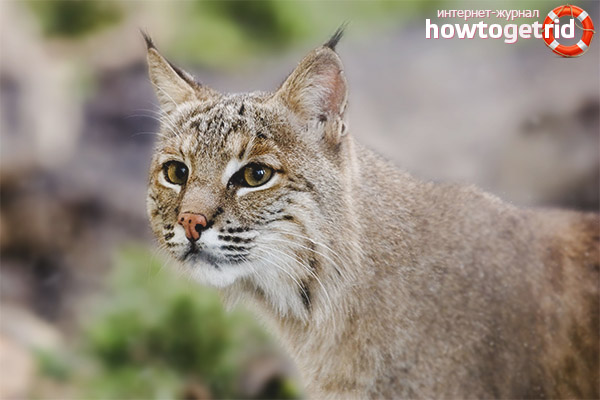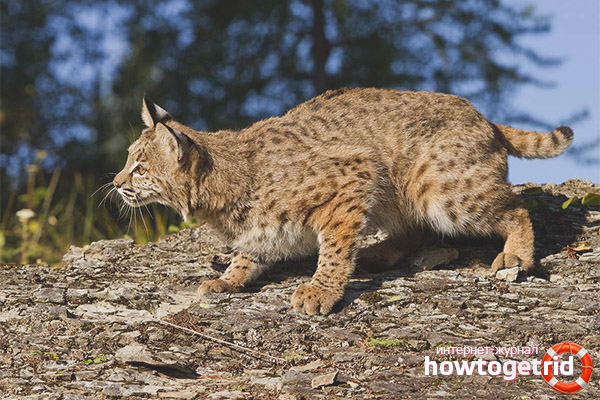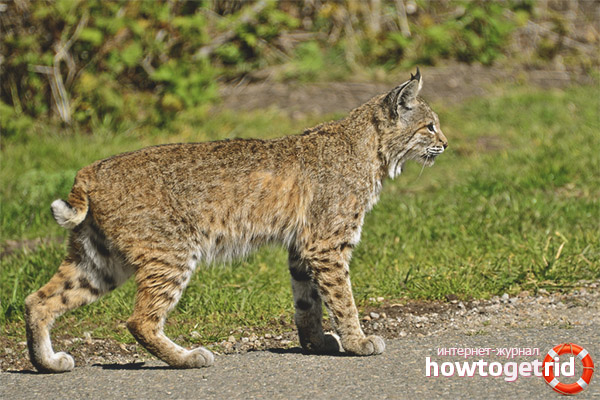The content of the article
The red or red lynx is a predatory animal that lives in North America. To some, it may be known as the “bobcat.” Despite its modest size, the red lynx is the largest predatory cat in its habitat. For many years now, it has been a mystery to zoologists. It is not easy to see and track it, although the lynx is not afraid of humans. That is why any grain of information obtained about it is of value.
general description
A bobcat is a relative of the usual lynx, but it is half the size. The body length rarely reaches 90 cm, and the weight ranges from 6 to 16 kg. Among individuals of this species, representatives with a weight of about 10 kg are most often found.
Her fur has a brown-red color with a lot of pigment (because of this, the red lynx is sometimes called red). Dark spots are scattered all over the fur, helping the beast to camouflage against the background of foliage and tall grass. In Florida, individuals with an exclusively black color are found. Cases of albinism among lynxes are also known. The tail is quite short relative to the body and is 15 cm. There is a white mark on it, by which the bobcat can be distinguished from other related species.
The body of the red lynx is very strong and lean. The prey that fell into these developed paws has no chance to get back, and the structure of the limbs allows the bobcat to make jumps 5 meters long, overtaking the pursued goal in two counts.
Spread
The habitat of this animal is entirely located on the American continent, which is a rather atypical phenomenon. The red lynx settles in the USA, in the south and the west of Canada, near the southern part of Mexico. Despite a fairly extensive resettlement, these cats are threatened with extinction due to uncontrolled extermination by humans.
Lifestyle
Bobcat's preferences in choosing housing are quite diverse. The beast can settle both in arid areas, and in marshy lowlands or forest thicket. Some individuals settle near human habitation and spend their whole lives amid the cultural landscape (the conditions created by man). Despite the fact that these animals perfectly mastered climbing trees, they do not use them for permanent living, preferring to climb up in case of danger or heat. They also swim quite rarely, preferring to do this only in the summer in order to cool.
Although the red lynx and dominates in size, it is not the main predator of the continent and has natural enemies. These include the Canadian lynx, cougar and jaguar, a meeting with which could end for a bobcat death.
The basis of the diet of red lynx is food of animal origin. She enjoys hunting rabbits, mice, porcupines and gophers. Sometimes a bobcat has the strength to defeat a white-tailed deer or livestock, but such cases are extremely rare. After prey, the red lynx advances at dusk.However, in the northern latitudes, it is less likely for her to get high-calorie food, so the bobcat uses any time of the day to hunt if there is potential food nearby.
After eating, the animal prefers to relax. If something is left of the meal, she carefully hides the traces of the recent feast. Like some other species of big cats, the red lynx can hide food on tree branches.
An important task for a red lynx is the protection of the territory, for which males scratch trees and make marks with urine. One animal can occupy an area of 100 square kilometers, and this is far from the limit. Females occupy approximately 50 square meters. km and defend their possessions as fiercely as males. Several males can divide the border area and provide their habitat for 3 females. Animals use the smell of urine to demonstrate their readiness for mating.
Breeding
The breeding season begins with the first warm days of spring. Females of the red-haired lynx bear the fruit for 53 days, after which a litter of several blind kittens is born. Babies begin to see clearly on day 7-9, after which they feed on breast milk for another 2 months. The milk of a female Bobcat is very fat and thick, it contains a large concentration of nutrients. Red lynxes treat kittens with care, constantly licking them. The female is always ready to take care of the offspring and, in case of danger, will transfer small predators to a new shelter.
Throughout all time, the male feeds all the females living on its territory. He will give them part of the booty, even if he himself is starving at the same time. This is a rather unique phenomenon, which is rarely found among other representatives of the animal world. For some time, the female does not allow the male to go to the hole, preferring to take food in neutral territory. But when the kittens grow a little older and stronger, the male is allowed to bring food directly to the shelter and leave the meat to the cubs for feeding.
Raising young lynxes is an important element in the life of a female. When the cubs reach the age of several months, she leaves the hole with them and begins to walk them on her own territory, teaching them the basics of hunting and protection from natural enemies. About six months later, the kittens already go to their first prey, which takes place under the strict supervision of the mother. This develops their stamina, providing physical activity. Throughout the entire period of growing up, kittens play with each other, which is also an important component of their physical development.
Hunting
The red lynx does not hunt in the pack, preferring to do this business alone. An interesting feature of the bobcat and other lynxes is that they can ambush and wait in the shelter for an unsuspecting victim. Lynx always kills prey in one and the same way: first gnaws the carotid artery, and then breaks the neck. The spontaneity of the attack allows her to hunt animals that are significantly larger than her in size.
Threat of extinction
The skin of a red lynx is a valuable trophy for which several thousand dollars are given on the black market. And the secrecy of the lynx and its fearlessness in front of man only adds excitement to poachers. Another reason why this species is hunted is the damage caused by farms to the red lynx. They attack birds and small animals, which is why farmers at the first opportunity try to eliminate the animal that has become impatient to visit their land.
At the moment, the red lynx is listed in the Red Book as a species that faces complete extermination. Attempts are being made to restore the population of the bobcat and multiply the individuals available in the zoos, but so far these actions have not yielded any special results.
Interesting and unusual facts.
- Lynx develops in water at the same speed as humans, and can also dive briefly.
- At an early age, the red lynx lends itself well to training and taming, so the kitten has every chance of becoming a full-fledged pet, which is kept outside the cage.
- The average life span of a Bobcat in nature is 18 years, in captivity - 30 years.
- The individuals of the red lynx living in the northern latitudes (for example, in Canada) are noticeably larger than their southern counterparts.
- In the first year of growing up, kittens add an average of 25 grams of weight per day.
- While jumping and walking, the red lynx sets its hind legs exactly to the place where its forelimbs were located a second ago. Despite the possibility of developing high speeds of movement, the lynx will not be able to pursue prey for a long time. If it was not possible to capture the victim in the first 30 seconds, then she will most likely leave her alone.
Video: Red Lynx (Lynx rufus)













Submit